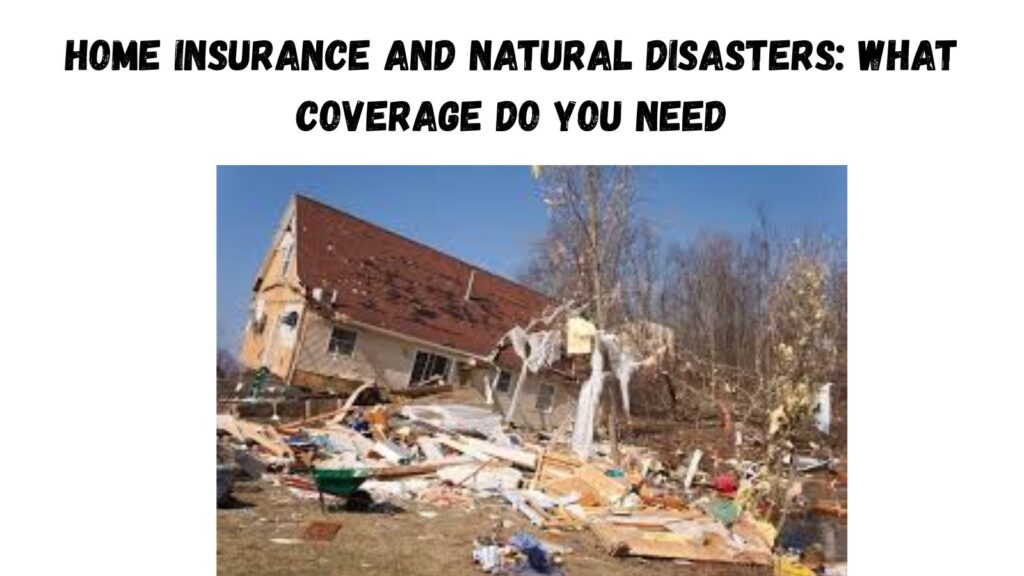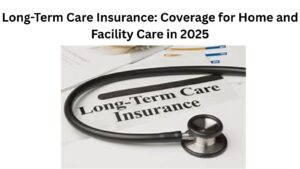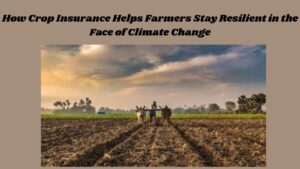In recent years, the frequency and severity of natural disasters have been on the rise, largely due to climate change. Natural disasters are hitting us harder. Hurricanes pound coastal areas, wildfires rage in dry regions, and floods drown cities. They are more frequent, widespread, and destructive than ever. A 2021 NOAA report says the U.S. had seven weather and climate disasters in 2020. Each disaster caused over a billion dollars in damage.
As homeowners, it is crucial to understand how your home insurance can protect you in the event of a natural disaster. Many people think their home insurance covers all natural disasters. Unfortunately, that’s not true. In fact, your typical home insurance may not cover damages caused by floods, wildfires, or even certain types of hurricanes. To ensure that you are fully protected, it is essential to know what’s included in your policy and what additional coverage you may need.

In this guide, we’ll look at the rising risk of natural disasters. We’ll discuss what a standard home insurance policy covers. Plus, we’ll share tips on getting the right coverage to protect your home and property.
The Impact of Natural Disasters on Homeowners
Contents
- 1 The Impact of Natural Disasters on Homeowners
- 2 What Does Home Insurance Typically Cover?
- 3 Additional Coverage for Natural Disasters
- 4 How to Ensure You’re Fully Protected
- 5 Fun Fact: The Costliest Natural Disasters in History
- 6 Conclusion: Protecting Your Home in an Unpredictable World
- 7 FAQs
- 8 Does home insurance cover flood damage?
- 9 Is wildfire damage covered under standard home insurance?
- 10 What should I do if I live in a hurricane-prone area?
- 11 How do I know if I need earthquake insurance?
- 12 Can I add flood insurance at any time?
Natural disasters can cause severe damage to homes and properties. FEMA says over 60% of declared disasters in the U.S. are weather-related. This includes floods, hurricanes, wildfires, tornadoes, and blizzards.
Here’s a snapshot of how some of the most common natural disasters impact homeowners:
- Floods: Floods are one of the most common and costly natural disasters. The National Flood Insurance Program (NFIP) says floods cause over $8 billion in damage each year in the U.S. In 2020, floods led to $1.3 billion in insured losses. Homes located in flood-prone areas, particularly those near rivers, coastlines, or lakes, are at the highest risk.
- Wildfires: Wildfires are a major issue, especially in the Western U.S. California, Oregon, and Washington often see fierce fires. These fires have destroyed thousands of homes. In 2020, California’s wildfires caused more than $12 billion in damage. With rising temperatures and prolonged droughts, this trend is expected to continue.
- Hurricanes and Tropical Storms: Coastal areas are at greater risk from hurricanes and tropical storms. These storms can bring heavy rain, strong winds, and dangerous storm surges. Hurricanes can cause huge damage. Hurricane Katrina in 2005 was one of the worst. It led to over $125 billion in losses.
What Does Home Insurance Typically Cover?
Home insurance protects homeowners from many risks. It’s crucial to know what is covered and what isn’t, especially regarding natural disasters.
1. Dwelling Coverage
- What it covers: This part of your home insurance pays for repairing or rebuilding your home. It applies if your home gets damaged or destroyed by events covered in your policy, like fire, vandalism, or theft.
- What’s not covered: Standard policies do not cover damage caused by floods, earthquakes, or landslides. If your area is prone to these types of natural disasters, you may need additional coverage.
2. Personal Property Coverage
- What it covers: This protects your belongings at home. It includes furniture, electronics, and clothing. These items are safe from risks like fire or theft.
- What’s not covered: Personal property coverage, including dwelling coverage, doesn’t protect against floods, earthquakes, or other natural disasters. You need to add extra coverage for that.
3. Liability Coverage
- What it covers: This protects you if someone is injured on your property or if you cause damage to someone else’s property.
- What’s not covered: Damage from natural disasters is usually under different policies. Liability coverage does not apply if a natural disaster causes damage.
4. Additional Living Expenses (ALE)
- What it covers: If your home is unlivable due to a covered event, ALE pays for temporary living costs, like hotel bills and food.
- What’s not covered: If you are displaced due to damage from a non-covered event (like a flood), ALE won’t apply.
Additional Coverage for Natural Disasters
If you live in a place at risk for floods, wildfires, or earthquakes, it’s important to have the right coverage. This way, you stay well protected. Here are some common add-ons to your standard home insurance policy:
1. Flood Insurance
- What it covers: Flood insurance is a separate policy that protects you from damage caused by floods. This is essential for homeowners in flood-prone areas, particularly if you live in a FEMA-designated flood zone. Standard home insurance does not cover flood damage.
- Real-Time Example: In 2017, Hurricane Harvey devastated Houston, Texas, with catastrophic flooding. Homeowners with flood insurance could recover their losses. However, those without it faced huge out-of-pocket costs for rebuilding.
2. Earthquake Insurance
- What it covers: Earthquake insurance is a separate policy. It protects you from damage caused by earthquakes. It typically covers the cost of repairing your home, as well as personal property and living expenses.
- Real-Time Example: After the Northridge Earthquake in 1994, California saw widespread destruction. Those with earthquake insurance were better equipped to rebuild, while those without were left to bear the cost of repairs.
3. Wildfire Insurance
- What it covers: Wildfire insurance helps pay for rebuilding or fixing your home after a wildfire. Some policies cover wildfires under a broader fire policy. So, it’s important to check if yours specifically includes wildfire damage.
- Real-Time Example: In 2020, California saw some of the largest wildfires in state history. Homeowners in wildfire zones with full fire insurance could rebuild. But those without proper coverage suffered big financial losses.
4. Hurricane and Windstorm Insurance
- What it covers: Most standard home insurance policies cover wind damage. However, if you live in a hurricane-prone area, you might need extra coverage for storm surges. These are often not included in basic policies.
- Real-Time Example: When Hurricane Katrina hit the Gulf Coast in 2005, many homeowners with hurricane insurance repaired and rebuilt their homes. However, those who didn’t have comprehensive windstorm coverage struggled to cover the damages.
How to Ensure You’re Fully Protected
To ensure that you’re fully protected against natural disasters, consider the following tips:
- Know Your Risk
- Understand the types of natural disasters that are most likely to affect your area. Contact local agencies like FEMA or the U.S. Geological Survey (USGS) for details on natural disaster risks in your area.
- Review Your Policy Annually
- Insurance needs can change over time. As you make home improvements, purchase more valuables, or relocate to a higher-risk area, your policy may need adjustments. Make sure you review your coverage regularly to ensure you’re adequately protected.
- Add Endorsements for Special Risks
- If your area faces risks like floods or wildfires, think about adding endorsements or riders to your policy. These additional coverages will ensure that you’re fully protected.
- Consider the Full Replacement Value
- Many insurance policies offer the option to insure your home and belongings for their actual cash value (ACV) or replacement cost. ACV accounts for depreciation, while replacement cost covers the full cost to repair or replace items, ignoring depreciation. For natural disaster scenarios, replacement cost coverage is recommended.
- Document Your Property
- Keep a detailed inventory of your home and belongings. This documentation can help streamline the claims process in the event of a disaster. Consider using apps or cloud storage to maintain digital records of your possessions.
Fun Fact: The Costliest Natural Disasters in History
The costliest natural disaster ever was the 2011 earthquake and tsunami in Japan. It caused over $235 billion in damages. In the U.S., Hurricane Katrina in 2005 is one of the most costly disasters, with losses exceeding $125 billion.
Conclusion: Protecting Your Home in an Unpredictable World
Natural disasters are happening more often and with greater strength. So, it’s crucial to have the right insurance to protect your home. A standard home insurance policy may not be enough to cover damages caused by events like floods, wildfires, and hurricanes. To stay fully protected, understand your policy. Check your risks and think about extra coverage for certain natural disasters.
Getting the right insurance can help you avoid big financial problems during a disaster. Remember, when it comes to home insurance and natural disasters, it’s always better to be over-prepared than underinsured.
The Impact of Climate Change on Homeowners Insurance: What You Should Expect
FAQs
Does home insurance cover flood damage?
No, standard home insurance policies do not cover flood damage. You must buy flood insurance from the National Flood Insurance Program (NFIP) or private insurers.
Is wildfire damage covered under standard home insurance?
Wildfire damage is typically covered under a standard home insurance policy, but it’s important to review the policy’s fine print. Homeowners in high-risk wildfire areas may need additional coverage.
What should I do if I live in a hurricane-prone area?
If you live in a hurricane-prone area, you should consider adding windstorm or hurricane insurance to your policy. Standard home insurance may not cover storm surges or other wind-related damages.
How do I know if I need earthquake insurance?
If you live in an area known for seismic activity, such as California, you may need to add earthquake insurance to your home insurance policy. Standard policies typically exclude earthquake damage.
Can I add flood insurance at any time?
Yes, you can purchase flood insurance at any time, but there’s a 30-day waiting period before the coverage takes effect. It’s best to secure flood insurance well in advance of hurricane season.


